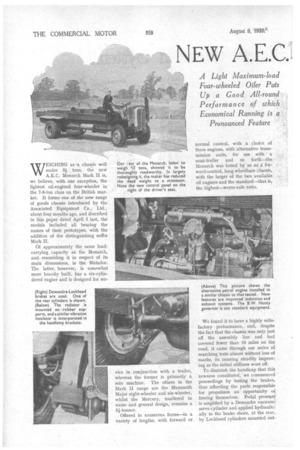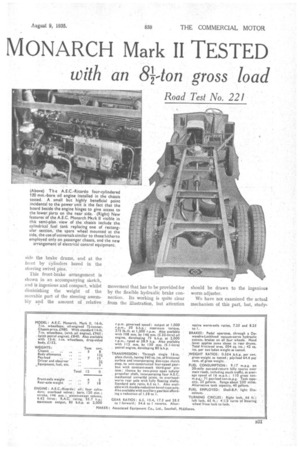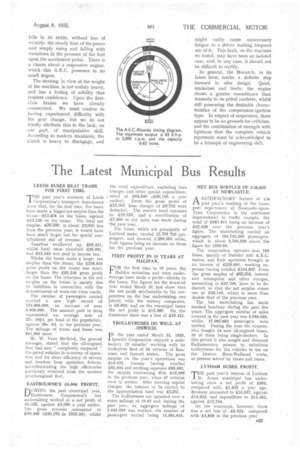EW A.E.C. MONARCH Mark II TESTED
Page 26

Page 27

Page 28

Page 29

If you've noticed an error in this article please click here to report it so we can fix it.
with an 81-ton gross load
Road Test No. 221
WEIGHING as a chassis well under ai tons, the new A.E.C. Monarch Mark II is, we believe, with one exception, the lightest oil-engined four-wheeler in the 7-8-ton class on the British market. It forms one of the new range of goods chassis introduced by the Associated Equipment Co., Ltd., about four months ago, and described in this paper dated April 5 last, the models included all bearing the names of their prototypes, with the addition of the distinguishing suffix Mark II.
Of approximately the same loadcarrying capacity as the Monarch, and. resembling it in respect of its main dimensions, is the Matador. The latter, however, is somewhat more heavily built, has a six-cylindered engine and is designed for ser vice in conjunction with a trailer, whereas the former is primarily a solo machine. The others in the Mark II range are the Mammoth Major eight-wheeler and six-wheeler, whilst the Mercury, unaltered in name and general design, remains a 54-tonner.
Offered in numerous forms—in a variety of lengths, with forward or normal control, with a choice of three engines, with alternative transmission units, for use with a semi-trailer and so forth—the Monarch was tested by us as a forward-control, long-wheelbase chassis, with the larger of the two available oil engines and the standard—that is, the highest—worm-axle ratio.
We found it to have a highly satisfactory performance, and, despite the fact that the chassis was only just off the assembly line and had
covered fewer than 10 miles on the road, it came through our series of searching tests almost without loss of marks, its running steadily improv ing as the initial stiffness wore off. To diminish the handicap that this newness constituted, we commenced proceedings by testing the brakes, thus affording the parts responsible for propulsion an opportunity of freeing themselves. Pedal pressnre is amplified by a Dewandre vacuumservo cylinder and applied hydraulically to the brake shoes, at the rear, by Lockheed cylinders mounted out side the brake drums, and at the front by cylinders bored in the steering swivel pins.
This front-brake arrangement is shown in an accompanying sketch, and is ingenious and compact, Whilst diminishing the weight of the movable part of the steering assembly and the amount of relative movement that has to be provided for by the flexible hydraulic brake connection. Its working is quite clear from the illustration, but attention should be drawn to the ingenious worm adjuster.
We have not examined the actual mechanism of this part, but, study ing the drawing from winch our sketch was made, we find ourselves wondering whether the heavy loading of the small area of teeth against which the worm bears will cause wear, for the clamp-grip cannot be relied upon to transmit the whole load, which is considerable. If this suggested criticism be not justified, the device should prove a most convenient and efficient means for adjustment Good retardation, however, is afforded, the braking force being just insufficient to lock the wheels. There is a slight time lag before the vacuum cylinder comes into operation, hence the improved results obtained when the hand brake is used as well. These are shown in an accompanying graph.
This manually applied brake is first class. Although acting on only the rear wheels, it is remarkably effective and does not require a specially strong pull upon the lever, whilst it is entirely adequate for holding the vehicle on a steep hill.
When the improvements effected to a chassis consist mainly of the elimination of unnecessary deadweight, it is hardly to be expected that increased liveliness will result, the gross weight remaining unchanged. The time required by the new Monarch to attain 30 m.p.h. from rest is about 60 secs. This is the same figure as is shown by our road-test analysis (compiled about a. year ago) for a typical oiler of 12 tons gross weight.
The acceleration in top gear from 10 m.p.h. to 30 m.p.h. is rather lower than that indicated by the Tapley Calculatot for a similar petrol vehicle, as would be expected, but there is no doubt that the curves shown in the accompanying acceleration graph could be considerably improved upon with a properly rumba engine.
For our consumption test, we n22 mansworth road, and back to, roughly, our starting point. This represents a distance of 20 miles, and is a rather difficult route in respect of hills and traffic. The vehicle was equipped with a calibrated test tank, which enabled accurate measurements of the quantity of fuel used to be made. On the double journey, 9.91 litres of fuel were consumed, which is equivalent to a rate of 9.17 m.p.g. and about 71 pay-load ton m.p.g.
A petrol-engined machine, closely comparable with the Monarch Mark II, which was tested by us some months ago, gave a return of approximately 52 pay-load ton m.p.g. The difference is a big argument in favour of the oil engine, despite the termination of the tax preference, and (in this case) the £125 extra cost.
Roxeth Hill, in Harrow, is a deceptive climb — looking much easier than it is. We estimate the gradient at 1 in 7, and on this slope carried out our stop-and-restart test. Hand brake and clutch functioned perfectly, but, on the high axle ratio, there was only just enough power available to get the vehicle in motion and to continue to propel it up the ascent.
On Sudbury Hill—the road into Harrow Hill from Wembley—a non, stop climb was made. No difficulty was encountered on this test, second gear being needed only for the steepest stretch between and including the two bends, and our speed never fell below 5 m.p.h.
Immediately after these two climbs a water temperature of 175 degrees F. was recorded, with an air temperature of well over 80 degrees F.
It was not until this series of trials had been completed that we fully appreciated the improvement in running that had been taking place during the day. Probably the " flogging " that the chassis had received on the hills—particularly the former—had contributed most to the engine's attainment of its full power output. The manner in which it behaved on the subsequent journey-. lug was unquestionably better than during the earlier stages of the day's run.
Maintaining a constant speed in. the neighbourhood of that at which it would normally be driven in actual service, the vehicle took all moderate hills in its stride, without loss of velocity, the steady beat of the power unit simply rising and falling with variations in the pressure of the foot upon,the accelerator pedal. There is a charm about a responsive engine, which this A.E.C. possesses in no small degree. The steering, In view of the weight of the machine, is not unduly heavy, and has a feeling of solidity that inspires confidence. Upon the firstclass brakes we have already commented. We must confess to having experienced difficulty with the gear change, but we do not wholly attribute this to the lack, on our part, of manipulative skill. According to modern standards, the clutch is heavy to disengage, and might easily cause unnecessary fatigue to a driver making frequent use of it. This fault, on the machine we tested, may have been an isolated case, and, in any case, it should not be difficult to rectify.
In general, the Monarch, in its latest form, marks a definite step forward in oiler design'. Quiet, smokeless and lively, the engine shows a greater resemblance than formerly 10 its petrol confrere, whilst still possessiag the desirable characteristics of the compression-ignition type. In respect of suspension, there appear to be no grounds for criticism, and the combination of strength with lightness that the complete vehicle represents Must be acknowledged to be a triumph of engineering skill.












































































